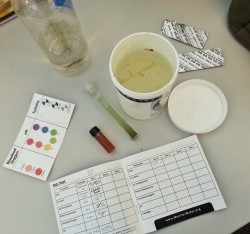
The World Water Monitoring Challenge results are out!
Earlier this year, I found myself hanging over a concrete ledge by the Charles River. But not to worry – it was nothing dire. I was actually trying to collect a water sample for the World Water Monitoring Challenge.
Talk about diving headfirst into citizen science.
On September 18 of each year, the WWMC encourages people around the world to test the quality of the water near them, share their findings, and become inspired to protect one of the most important (if not the most important) resource on our planet. The entire program runs annually from March 22 (the United Nations World Water Day) until December 31.
The primary goal of the WWMC is to educate and engage citizens in the protection of the world’s water resources. Their philosophy is this: conducting simple monitoring tests teaches participants about common indicators of water health and encourages further participation in more formal citizen monitoring efforts.
It doesn’t just end with submitting your water sampling data. The WWMC make it a point to report the results back to participants each year in an annual report. The data for this year are now available online and open for all to see.
Citizen scientists across 6 continents and 51 countries participated. Taiwan alone reported 92,023 individual efforts. Within the U.S., Florida took the lead with 10,143 reported individual efforts. In all, 10,371 water test kits were distributed.

*The data in this graph represent the mean average results for regions listed in the map, spanning from 2009 to 2013. The results reported for WWMC do not constitute a completely thorough and accurate portrayal of the health of the world’s water. Accurate water quality monitoring requires the use of standard quality assurance protocols and is conducted by trained volunteer monitoring groups and professionals around the world.
WWMC participants sampled local lakes, streams, rivers, ponds, reservoirs, and other water bodies and ran simple tests for four key water quality indicators: dissolved oxygen, pH levels, temperature, and turbidity. (Learn more about why these things are important to measure when it comes to water quality monitoring.) Some groups even tested for the presence of macroinvertebrates such as dragonflies, mayflies, and scuds. Samples were taken in a range of settings – agricultural, commercial, residential, and industrial.
This project is ideal for anyone who lives near a water source, educators who want ideas to teach students about water chemistry, or citizen scientists hoping to get their feet wet with an increasingly important field of research.
References:
Full World Water Monitoring Challenge 2013 report
Images: www.worldwatermonitoringday.org
Lily Bui is the Executive Editor of SciStarter and holds dual degrees in International Studies and Spanish from the University of California Irvine. She is also the STEM Story Project Associate for Public Radio Exchange (PRX) in Cambridge, MA. This fall, she’ll be a masters candidate in MIT’s Comparative Media Studies program. Previously, she helped produce the radio show Re:sound for the Third Coast International Audio Festival, out of WBEZ Chicago. In past lives, she has worked on Capitol Hill in Washington, D.C.; served in AmeriCorps in Montgomery County, Maryland; worked for a New York Times bestselling ghostwriter; and performed across the U.S. as a touring musician. In her spare time, she thinks of cheesy science puns. Follow @dangerbui.


